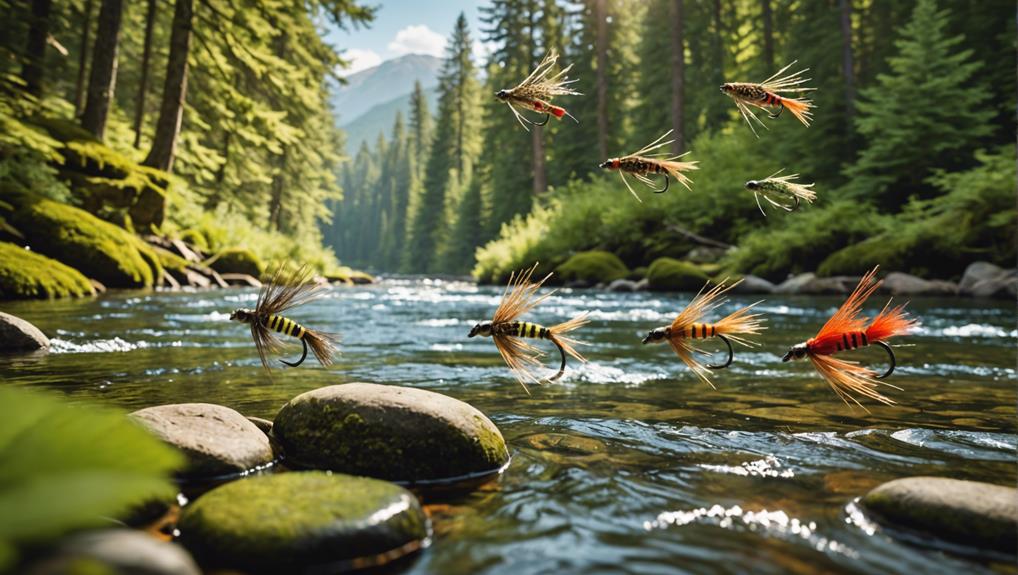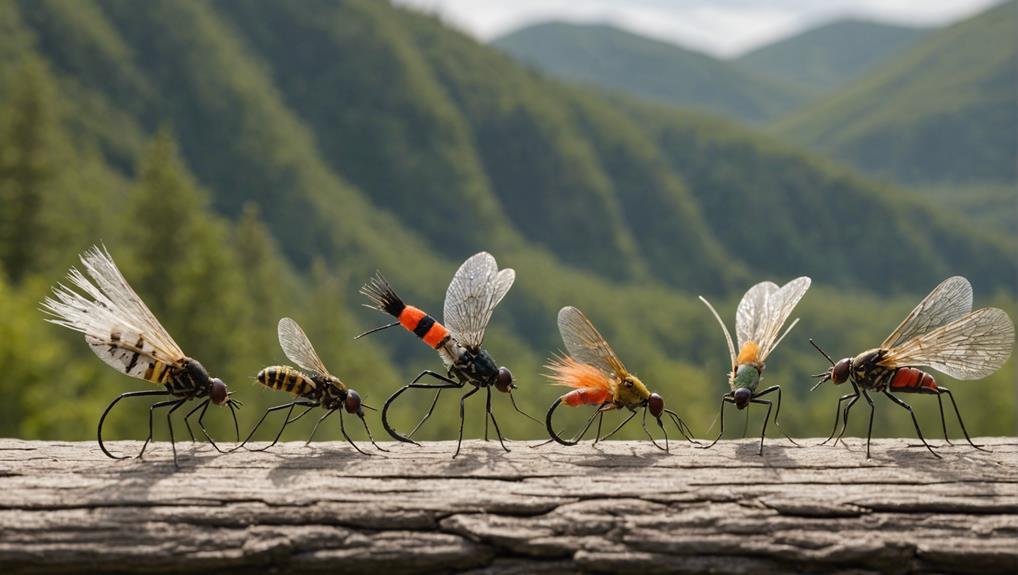In July, you’ll want to make sure your fly box includes versatile and effective options. Start with the Beadhead Prince Nymph and Bead Head Pheasant Tail Nymph, known for mimicking a range of aquatic insects. Add a Pink Squirrel for its eye-catching appeal and the quick-sinking Egans Tungsten Dart for deeper areas. Don’t overlook the surface; a high-vis Sparkle Dun or RS2 matches the hatch perfectly as emergers. These selections cater to various hatches and trout behaviors. Combining these top flies increases your chances of a successful catch. Equip yourself with these essentials, and you’re on your way to more exciting encounters on the water.
Key Takeaways
- Opt for high-visibility dry flies like Chernobyl Ant to match prevalent terrestrial activity in July.
- Include Beadhead Prince Nymphs that mimic diverse aquatic insects, essential during summer hatches.
- Use Pink Squirrel nymphs for their vibrant appeal, attracting trout in diverse water conditions.
- Select emergers like Sparkle Dun to imitate insects transitioning to adulthood, effective in calm waters.
- Experiment with Woolly Buggers, adjusting retrieve speed to mimic baitfish, effective in both clear and murky waters.
Selecting Dry Flies
When selecting dry flies for your July trout fishing, opt for those that mimic the prevalent insect hatches like mayflies and caddisflies. Matching hatches is essential as it guarantees your fly resembles the natural insects trout are actively feeding on. This strategy enhances your chances of a successful catch. Focus on the size, shape, and color of the natural insects being imitated. For example, if you notice pale morning duns on the water, select a dry fly that mirrors this appearance.
In terms of color selection, it’s not only about matching the hatch but also choosing a fly that you can see against the water’s surface. High visibility dry flies, especially those with bright colors or indicators, are advantageous during low light conditions or when fishing in choppy waters. This helps in keeping track of your fly and reacting promptly to strikes.
Experimenting with various fly patterns within the mayfly and caddisfly families can also be effective. Some trout can be selective, and subtle differences in pattern or size can make a significant impact. Always be prepared to adjust your choice based on what the trout are responding to at a given time.
Essential Nymph Patterns
Shifting to nymph patterns, consider the Beadhead Prince Nymph and Bead Head Pheasant Tail Nymph as essential choices for July trout fishing. As trout are actively feeding on nymphs, your nymph selection and tactics must be excellent. Here’s what you should have in your fly box:
- Beadhead Prince Nymph: A versatile fly that mimics various aquatic insects. Its flashy bead helps attract trout in deeper or murkier waters.
- Bead Head Pheasant Tail Nymph: Excellent for imitating mayflies, a primary food source in July. Its slender profile perfectly matches the natural insects.
- Pink Squirrel: Don’t overlook this slightly unconventional nymph. Its vibrant color and enticing profile often prove irresistible to trout.
- Egans Tungsten Dart: This one sinks quickly and is perfect for reaching those deeper spots where big trout lurk during the hot midday sun.
Incorporating these patterns into your seasonal nymphing strategies can greatly enhance your success rate. Remember, the key to effective nymph fishing isn’t just about having the right flies, but also understanding the behavior of trout in July. Adjust your techniques as needed, and you’ll be set for a rewarding session on the water.
Top Streamer Choices

As you explore streamer options for July trout fishing, consider starting with Woolly Buggers, Sculpin patterns, and Zonkers to effectively mimic the larger prey items trout are targeting this season. These streamers, ranging in sizes 4-10, are perfect for matching the hatch and drawing aggressive strikes from trout.
When it comes to streamer techniques, focus on varying your retrieve speed to replicate the natural movement of baitfish or leeches. A slower, more deliberate retrieve can often entice wary trout, while a quicker, erratic retrieve might trigger an aggressive response from an actively feeding fish. Pay attention to the feedback from the water; if one method isn’t working, don’t hesitate to switch it up.
Additionally, consider the conditions of the river or lake when selecting your fly. If the water is murky, go for streamers in brighter colors to stand out. In clearer waters, opt for more natural, subdued tones to avoid spooking the fish. Casting tips also play an important role; make sure your casts are precise to place your streamer right where the trout are most likely to be. This strategic approach to fly selection and casting will greatly enhance your chances of a successful outing.
Effective Emerger Flies
While streamers effectively mimic larger prey, emerger flies like the Sparkle Dun and RS2 are key for imitating the subtler action of insects as they evolve into adulthood. These patterns are especially effective as they capture the critical transformation phase from nymph to flying adult, a favorite target for feeding trout.
Here’s why you should consider using emerger flies:
- Realistic Appearance: Emergers like the CDC Emerger sit partially submerged, presenting a vulnerable state that trout find irresistible. Their design mimics the struggling insect trying to break free from the water surface, which triggers aggressive strikes.
- Matching the Hatch: When you notice a hatch underway, switch to an emerger pattern. Trout often key in on these easy targets due to their abundant presence. Matching the hatch with the correct emerger increases your chances of success.
- Presentation Tactics: Achieving a drag-free drift is vital. Cast upstream and allow the fly to float down naturally, mimicking an emerging insect. This technique often convinces selective trout that the fly is a genuine emerging insect.
- Water Conditions: Emergers perform best in calm or slightly rippled water. Here, trout are more likely to spot and hone in on the subtleties of an emerging insect.
Understanding these entomology insights and adapting your fishing techniques accordingly will enhance your effectiveness on the water.
Attractors and Terrestrials

Consider leveraging attractor and terrestrial flies like the Chernobyl Ant and Hi-Viz Foam Beetle, which prove highly effective in stimulating trout strikes during the warm July waters. These flies have bright colors and unique shapes that grab the attention of trout, looking for an easy meal on the surface. You’ll also find success with patterns like the Pink Squirrel and Morrish Hopper, which mimic the land-based insects abundant in summer.
When you’re tying these flies, focus on durability and visibility. Adding a bit of flash or using high-contrast materials can make a significant difference. Remember, presentation techniques are key with these flies. Aim for soft landings on the water to mimic the natural fall of terrestrial insects. Adjust your approach based on water conditions; in slower currents, give your fly subtle twitches to mimic struggling insects.
Also, don’t forget to match the hatch. Even though attractors are designed to stand out, choosing a size and color that reflects local insects can increase your catch rate. The Euro Pink Squirrel Fly, for instance, offers a twist on the traditional pattern with a hint of flair that can be particularly tempting to trout in clear water conditions. Keep these tips in mind, and you’ll likely see your success rate soar this July.
Frequently Asked Questions
What Flies Hatch in July?
In July, you’ll find caddisflies, mayflies, and stoneflies hatching, along with active terrestrials like grasshoppers. Remember, regional variations may affect these hatches, so adapt your fly selection accordingly to what’s emerging.
What Is the Most Successful Fly for Trout?
The most successful fly for trout depends on local trout feeding behaviors and prevalent hatches. Mastering fly tying techniques helps mimic these insects, increasing your chances of a successful catch.
What Is the Best All Around Fly Line for Trout?
For trout, your best bet is a weight-forward floating fly line. It’s versatile and improves casting accuracy. Don’t forget line weight selection and regular maintenance to keep your line in top condition.
What Is the Easiest Fly to Catch Trout On?
You’ll find the Parachute Adams to be the easiest fly for catching trout. It’s a top choice due to its visibility and effectiveness. Perfect your fly selection strategy with this beginner-friendly option.
Conclusion
Now that you’ve got the rundown on July’s top trout flies, you’re all set to hit the water.
Keep your fly box stocked with these essential dry flies, nymphs, streamers, emergers, and attractors.
Whether you’re casting in a bustling river or a tranquil lake, these selections will boost your chances of a great catch.
Remember, the right fly can make all the difference—so choose wisely and enjoy the thrill of the catch!
Happy fishing!